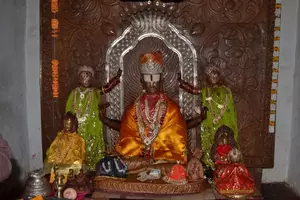History of Muktinath Temple
Home »
 The Hindu Temple of Muktinath which is situated within the beautiful mustang valley in Nepal is one of the most significant places of worship for the devotees of lord Vishnu. The humble temple containing the 108 Mukti Dharas is also a prime place of worship for Buddhist followers as well. People brave the tough terrain, uncertain weather conditions and other such unexpected situations to reach the ultimate destination for attaining salvation by bathing under the Mukti Dharas. While visiting this holy place you will be enamoured with the amazingly surreal beauty of the surroundings which seems to go on till the horizon. The beauty, spirituality and the overall feeling of rejuvenation from inside out is something which cannot be put to words and can only be experienced. What makes this place so special? Here are a few things that you may not have known about this incredibly significant abode of lord Vishnu.
The Hindu Temple of Muktinath which is situated within the beautiful mustang valley in Nepal is one of the most significant places of worship for the devotees of lord Vishnu. The humble temple containing the 108 Mukti Dharas is also a prime place of worship for Buddhist followers as well. People brave the tough terrain, uncertain weather conditions and other such unexpected situations to reach the ultimate destination for attaining salvation by bathing under the Mukti Dharas. While visiting this holy place you will be enamoured with the amazingly surreal beauty of the surroundings which seems to go on till the horizon. The beauty, spirituality and the overall feeling of rejuvenation from inside out is something which cannot be put to words and can only be experienced. What makes this place so special? Here are a few things that you may not have known about this incredibly significant abode of lord Vishnu.
History of the Temple
The temple ranks 106th among the 108 holy Divya Desam that is scattered all over the country and is deemed of great religious importance to the Sri Vaishnava sect of followers. The ancient name of the temple has found its mention in various Vaishnava literature prior to being connected to being a Buddhist origin. The central feature of the temple is a Shaligram Shila which is said to have been formed here on its own as a miracle from the Hindu godhead or a naturally available form of Sriman Narayan. Although this temple’s origin can be traced back to the Vaishnava traditions, in Buddhism this place has been mentioned as a Chumig Gyatsa which in Tibetan translates into “hundred waters”. Among Buddhists this is the place where Guru Padmasambhava is said to have performed his meditation for a really long time. among other Buddhists this is the place very significant for Dakinis or the goddesses who are referred to as the sky dancers who according tot their teachings signifies complete compassion for all buddhas.
Hindu Legend
This particular Vishnu temple ranks among one of the oldest temples in the world. As per the Hindu mythological account there once ensued a massive battle between lord shiva and Jalandhar the powerful king of all the demons. He is said to have been extremely evil minded and he is also said to have attacked the kailash parvat (the abode of Shiva Parvati) in an attempt to get Parvati. To get away with it he had converted himself into a duplicate of the lord, however due to the Parvati’s spiritual powers she recognised who it really was and called shiva for help. This ended up in a battle between the two. The gods decided to trick Jalandhar’s wife Vrinda, on advice of lord Vishnu. He turned himself into Jalandhar and behaved like Vrinda’s husband. She lost her devotion and shiva was able to slaughter the demon king. Scorned, Vrinda cursed Vishnu that he will turn into a stone for destroying her devotion to her husband.
Another Hindu legend tells us about how after sati was killed Shiva’s mourning began and he took her body everywhere he went. Vishnu wanted shiva to snap out of it and come back to his sense since the world needed him. He cut up her body into 52 different pieces which are now worshipped in the form of Shakti Peeths in India. Muktinath is considered to be one such shaktipeeth where her mouth is worshipped.
Buddhist Legend
Amongst the followers of Buddhism, the temple of Muktinath is popular with the name of Chumming Gyatsa and is also among one of the prominent tantric places in india and in the world. This temple is home of 21 taras and also the Dakinis goddesses or the sky dancers. The founder of Tibetan Buddhism Guru Rinpoche aka Padmasambhava used to meditate here while on his way to Tibet from India. Nearby the temple of muktinath there is a place called Damodar Kund (Men-Chu in Tibetan language) which is the main and primary source of river kali Gandaki and Saligram.
Legend Related to Mukti Dhara
This place is located right on the courtyard of the temple of muktinath and consists of 108 water spouts through which the cold and freezing water of kali Gandaki River flows. According to the Hindu astrology this place represents the 12 zodiac signs and 9 planets in the solar system. Hence there is a popular belief that bathing oneself under these 108-bull faced Mukti Dhara / water spouts will wash out all our sins. The interesting fact about the place is that it favours a mutual respect for every religion and as per the Hindu religion it also provides salvation or Mukti.

Leave a Reply